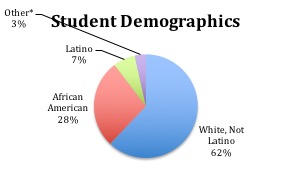"Exploring the Benefits of Blog Use in First-Year Composition: A Pilot Study"
|
Jennifer HewerdineJennifer M. Hewerdine recently earned her Ph.D. from Southern Illinois University - Carbondale. She currently works for the Haslam College of Business at the University of Tennessee. Her research interests include multi- and eco-literacies, collaboration, and the development of ethos. Contents |
ResultsFrom the surveys, I learned that 62% of students identified as white, 28% African American, 7% Latino, and 3% (one student) identified as other (white and African American) (see Figure 1). The student population was 52% female (15 students) and 48% male (14 students). Of those participating, 45% reported that they were first generation college students (13 students).
Figure 1 Student Demographics
The survey also asked students to report how frequently they used social media: 35% percent reported using social media several times a day, 52% reported using social media daily, 10% reported using it weekly, and 3% reported seldom use of social media (see Figure 2). When asked what they used social media for, students reported viewing videos, looking at photos, linking to and following links to external sites, and reading articles. Figure 2 Reported Social Media Use
Two of the students said they preferred writing with a pen and paper, while the other 27 students said they preferred to type their papers on the computer. Prior to starting the blog, all but two of the students who participated found the idea of blogging interesting, with one of the two students saying that the blog was not interesting because the student preferred Tumblr. At the end of the semester, 93% of the students (27 students) reported that the blog was beneficial to their learning and/or writing. Ten students (34%) experienced problems with using the blog. The problems fell into three categories: the blog did not allow for MLA formatting, the blog would fail to publish sometimes, and two students cited interference from the English department with regard to their blog, as I will address later. From the interviews and observations, I identified four constructs of writing that appeared to be approached differently when composing in blogs as opposed to traditional venues: public audience awareness, agency, ownership, and metacognitive use. The first, audience awareness, according to David Bartholomae (2003), is vital for students to learn in order to become proficient in academic writing (p. 623). Many institutions desire a diverse student body, but recruiting a diverse student body requires that institutions identify ways of incorporating diverse identities into the academic life of the institution. Christina V. Cedillo (2017) argues that students from marginalized and/or minority groups “must be allowed to honor rhetorical praxes located within their extramural communities” (n.p.). Composition courses can do so by incorporating student agency into writing, thereby allowing students to perform their identity, address sites of conflict, and speak to topics that are socially and globally relevant. Ownership, another construct I identified within students’ blog practices, is difficult to define and separate from agency, but based on my observations, I define ownership as students’ perceived control over their blog space and words. Metacognition, “the monitoring and controlling of thought,” signifies students are considering and reflecting on the choices they make when writing; the implications for increased metacognition and reflection extend beyond the writing classroom and into everyday interactions and critical thinking (Martinez, 2006, p. 696). In this article, I address how, based on my observations, blogging may help students to critically question, analyze, and evaluate ideas, allowing them to engage in the conventions of the academic community by situating writing in a dynamic writing environment that encourages greater reflection and extended feedback on their ideas. |

